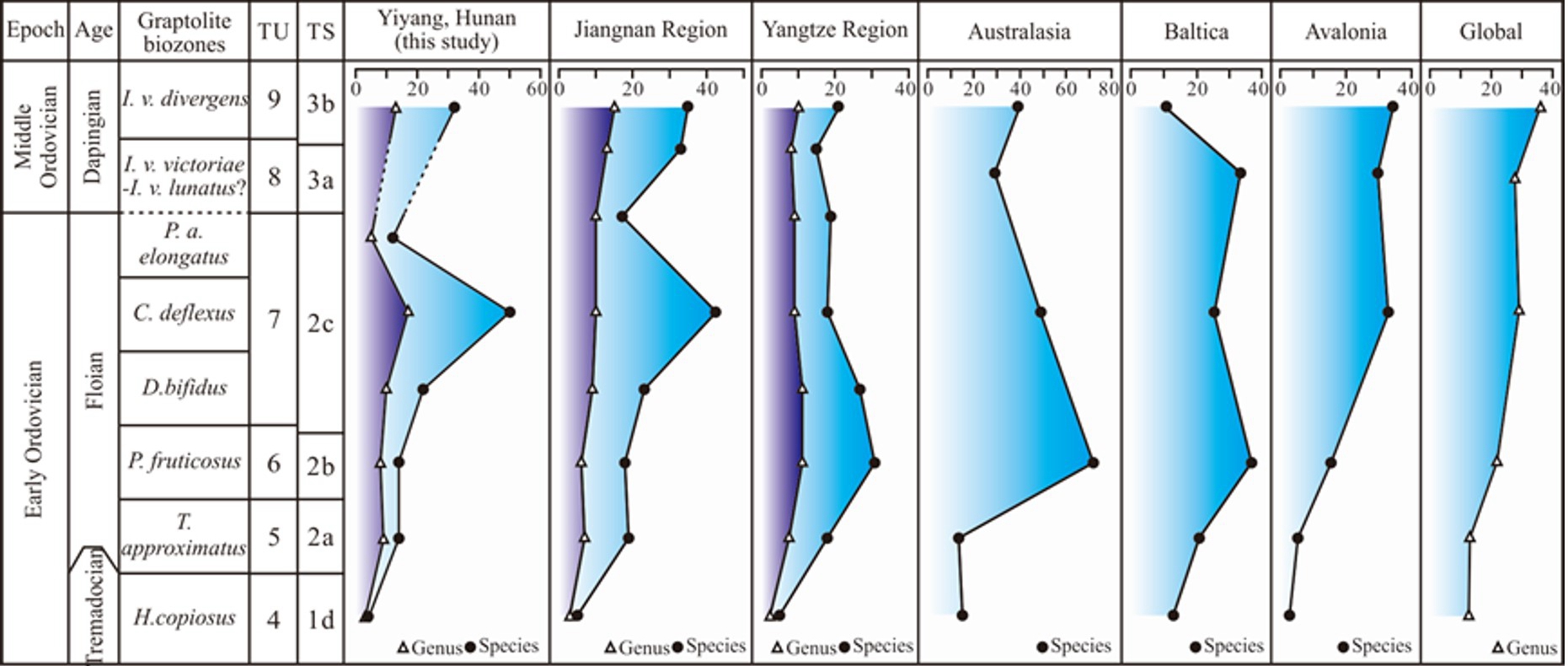Graptolites, one of the major groups in Ordovician oceans, sharply increased in diversity, through high evolutionary rates and a dramatic expansion of ecospace. Many preliminary studies have been conducted on graptolite diversification during the Ordovician. On a global scale, the Floian–Dapingian interval witnessed the most significant diversification of the Dichograptid fauna. A large number of taxa belonging to the Dichograptid fauna originated and subsequently diversified in this interval, which directly affected the macroevolution of three Ordovician graptolite faunas: the Anisograptid fauna, Dichograptid fauna, and Diplograptid fauna. However, on the same animal phylum on different blocks and environments may exhibit quite different macroevolutionary patterns. Thus, greater focus should be placed on collecting diversity data of one fossil group from different blocks in a regional context.
Recently, Dr. LI Lixia from Nanjing Institute of Geology and Palaeontology, Chinese Academy of Sciences and colleagues from Nanjing University investigated graptolite diversification in detail, bed-by-bed analysis, and through each graptolite biozone based on Floian–Dapingian graptolites from the Ningkuo Formation of the Nanba section in Yiyang, Hunan province, South China. In order to elucidate the graptolite diversity pattern during the Floian and Dapingian and explore the comparison of graptolite diversity within South China and other palaeoplates, as well as with different major fossil groups in South China. The possible triggering factors of graptolite diversification were also briefly discussed.
The detailed study of the graptolite fauna from the Lower to Middle Ordovician Ningkuo Formation in the Nanba section, Yiyang, Hunan Province, reveals variable but generally increasing diversity during the Floian–Dapingian, peaking in the Corymbograptus deflexus Biozone. The diversification trend of graptolites in the Nanba section is broadly consistent with that in the Jiangnan region of South China and Avalonia, but is delayed compared with that in the Yangtze region of South China, Australasia, and Baltica. Furthermore, the first peak in diversity of graptolites in the Nanba section slightly post-dates that of brachiopods and conodonts, but is earlier than that for trilobites and acritarchs. Comparison of diversity trends with the sea-level curve for the Yangtze Platform reveals that the Early and Middle Ordovician graptolite radiation coincided with a transgression. Graptolite diversity trends through this interval initially reflect replacement of Anisograptid fauna by Dichograptid fauna and subsequent commencement of evolution within the Dichograptid fauna.
This study is supported by the National Natural Science Foundation of China (NSFC) (Nos. 41372017, 41521061, 41290260), and the State Key Laboratory of Palaeobiology and Stratigraphy (LPS) (No. 143103).
Article information: Li-Xia Li, Hong-Zhen Feng, Wen-Hui Wang, Wen-Jian Chen. 2017. Graptolite diversification during the Floian and Dapingian (Early-Middle Ordovician): A case study from the Ningkuo Formation of Hunan Province, China.Palaeoworld, 26: 431–443.

Comparison of graptolite diversity curves in this study with those of Jiangnan and Yangtze regions (Zhang and Chen, 2006), Australasia, Baltica, Avalonia(Cooper et al., 2004) and Global (Chen et al., 2006).

Comparison of graptolite diversity curves in this study with those of brachiopods (Zhan et al., 2005), acritarchs (Li et al., 2007), trilobites (Zhou et al., 2007),and conodonts (Wu et al., 2010) in South China.
